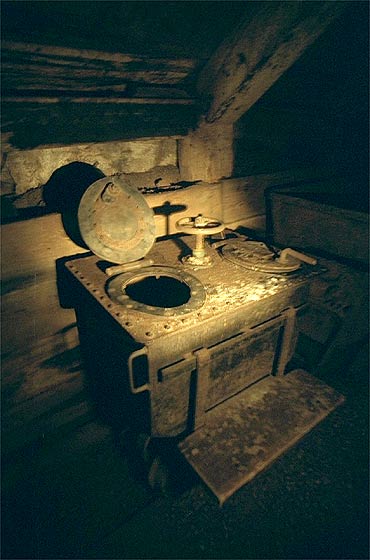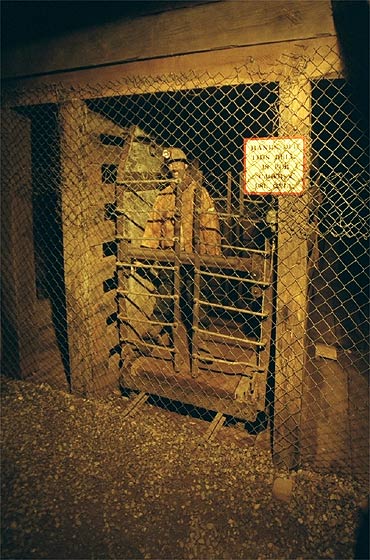Bisbee Arizona Historic Town

Bisbee was the acknowledged "Queen of the Copper Camps". With a mining life of almost a century and a peak population of 35'000 , Bisbee attained a permanence rare among mining towns. Despite floods, fires, labor troubles and mine shutdowns and reopenings, Bisbee endured. Now, even though the mines have closed, the Bisbee people scorn the idea that their jewel in the canyon is a "ghost town".
bisbee1085-036 (© 2001 by Daniel Ter-Nedden) Buy pictures

The town was named Bisbee in honor of San Francisco judge De Witt Bisbee, an investor who never saw the camp. it was a dangerous place in its early days, with Apache raids still a possibility. As a result, school children had "Indian drills". When they heard the whistle blow two shorts, a long, and a short, they were to scurry to the safety of mine shafts.
bisbee1085-040 (© 2001 by Daniel Ter-Nedden) Buy pictures

By 1878, copper was paying off so well that it was profitable to freight ore to Benson and send it by rail all the way to Pennsylvania for smelting. Since profits would increase substantially by shipping a finished product, smelting operations began by the next year. .....
bisbee1085-052 (© 2001 by Daniel Ter-Nedden) Buy pictures

........Within a few years, the once-forested Mule Mountains were denuded for firewood and the polluting fumes of smelters choked the canyons and gulches where the town developed. But only a few Citizens complained, as they saw dollars in the sulfurous clouds. Those who could afford it, built their homes amidst the cleaner on the hills above the town.
bisbee1085-045 (© 2001 by Daniel Ter-Nedden) Buy pictures

In 1901 Copper Queen Consolidated extended a company-owned railroad, the El Paso and Southwestern, 25 miles to Douglas, where a smelter was built. A year later the Calumet and Arizona, two other mining companies with mines near Bisbee, also erected a smelter there, thus ending the choking pollution that had engulfed Bisbee. As it became a far more pleasant place to live and work, Bisbee became known by the sobriquet "Little San Francisco".
bisbee1085-049 (© 2001 by Daniel Ter-Nedden) Buy pictures

Like the City by the Bay, Bisbee had its disasters. A year after the 1906 San Francisco Earthquake, a fire roared across Chihuahua Hill, destroyed residences and many businesses along Brewery Gulch. A year later, another conflagration wiped out buildings of Bisbee's upper Main Street and dozens of homes. Many structures had to be dynamited to create a firebreak. The estimated loss was $ 500'000.
bisbee1082-041 (© 2001 by Daniel Ter-Nedden) Buy pictures

Because the denuded hills above the town could not absorb rainfall as they once had, Bisbee also suffered repeatedly from flooding. In addition to natural disasters, a series of typhoid epidemics swept through town.
Nevertheless, Bisbee prospered. In addition to copper, the town became the shipping center for surrounding cattle ranches and the financial center for American-owned mines at Cananea and Nacozari in Sonora, Mexico.
Nevertheless, Bisbee prospered. In addition to copper, the town became the shipping center for surrounding cattle ranches and the financial center for American-owned mines at Cananea and Nacozari in Sonora, Mexico.
bisbee1085-050 (© 2001 by Daniel Ter-Nedden) Buy pictures

Until the closing of all mines in 1974, it is to say that two remarkable open pit mines were opened, the Sacramento Pit (opened 1917 and closed in 1931) as well as the Lavender Pit (opened 1951 and closed in December 1974). Bisbee had produced more than 8 billion pounds of copper worth about $2 billion. In the process, the mines had also yielded 3.9 million pounds of lead, 3.8 million pounds of zinc, 2.7 million ounces of gold, and more than 1 million ounces of silver.
bisbee1081-084 (© 2001 by Daniel Ter-Nedden) Buy pictures

By 1975 Bisbee was just another place that had joined the long list of former mining camps on their way to obscurity. Or so it might have seemed. Bisbee, which could easily have become a derelict, has rebounded, not retired. After the closing of the mines, Phelps Dodge relocated many of its workers to other operations. The town retained the county seat and some lifelong residents chose to stay.
They were joined by retirees who found comparatively inexpensive housing in a lovely location, and by young artists, photographers, and craftsmakers who began small businesses. We personally liked the mix of the old and new very much. The population now is about 9000 people.
They were joined by retirees who found comparatively inexpensive housing in a lovely location, and by young artists, photographers, and craftsmakers who began small businesses. We personally liked the mix of the old and new very much. The population now is about 9000 people.
bisbee1085-053 (© 2001 by Daniel Ter-Nedden) Buy pictures

We liked Bisbee very much as it is a beautiful, charming place. In addition, there is the underground Queen Mine tour, which we believe is just excellent and very informative.
bisbee1085-051 (© 2001 by Daniel Ter-Nedden) Buy pictures

Historic photograph on display at the mine. The mules went blind after being held inside the darkness for many years.
bisbee1086-102 (© 2001 by Daniel Ter-Nedden) Buy pictures

A mobile toilet for miners, seen inside the Copper Queen mine
bisbee1085-021 (© 2001 by Daniel Ter-Nedden) Buy pictures



